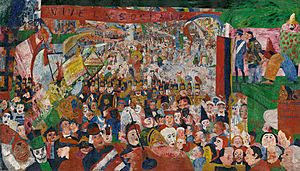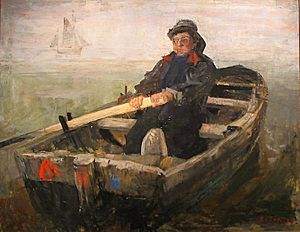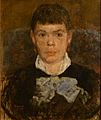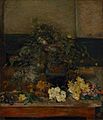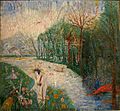James Ensor facts for kids
Quick facts for kids
James Ensor
|
|
|---|---|
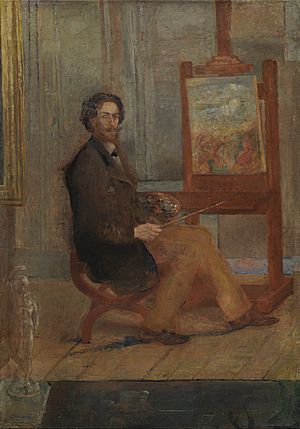
Self-Portrait of James Ensor by his Easel, 1890
|
|
| Born |
James Sidney Ensor
13 April 1860 |
| Died | 19 November 1949 (aged 89) |
| Nationality | Belgian |
| Education | Académie Royale des Beaux-Arts, Brussels (Belgium) |
| Known for | Painting, graphic arts |
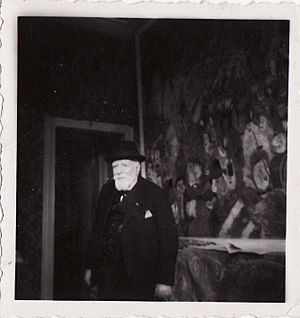
James Ensor (born April 13, 1860, died November 19, 1949) was a famous Belgian artist. He was a painter and a printmaker. Ensor had a big impact on art styles like expressionism and surrealism. He lived most of his life in a city called Ostend in Belgium. He was also part of an art group called Les XX.
Contents
Biography
James Ensor's father was James Frederic Ensor. He was born in Brussels to English parents. His mother, Maria Catherina Haegheman, was Belgian.
Ensor was not very interested in school. He left at age fifteen to start learning art. He trained with two local painters. From 1877 to 1880, he went to the Académie Royale des Beaux-Arts in Brussels. A famous artist named Fernand Khnopff was one of his classmates there.
Ensor showed his artwork for the first time in 1881. From 1880 until 1917, his art studio was in the attic of his parents' house. He did not travel much. He made only a few short trips to France and the Netherlands in the 1880s. He also took a four-day trip to London in 1892.
Becoming a Famous Artist
In the late 1800s, many of Ensor's artworks were not accepted. Some people even found them shocking. But Ensor's paintings continued to be shown. Slowly, he became more accepted and famous.
In 1895, a museum in Brussels bought his painting The Lamp Boy (1880). This was the Royal Museums of Fine Arts of Belgium. He also had his first solo art show in Brussels that year.
By 1920, his art was featured in big exhibitions. In 1929, the King of Belgium, King Albert, gave him the special title of Baron. A Belgian composer named Flor Alpaerts even wrote music about him called James Ensor Suite. In 1933, Ensor received an important French award, the Légion d'honneur.
Alfred H. Barr, Jr., who started the Museum of Modern Art in New York, saw Ensor's 1887 painting Tribulations of Saint Anthony. He said Ensor was the bravest painter working at that time.
Later Life
Even in the early 1900s, Ensor started painting less. He spent more and more time on music. He never had formal music lessons. But he was very good at playing the harmonium without practice. He often played for his visitors.
Ensor stayed in Ostend during World War II. His friends told him to leave because of the danger of bombings. But he chose to stay. In his old age, he was a respected person in Belgium. People in Ostend often saw him on his daily walks. He passed away in Ostend on November 19, 1949, at 89 years old, after a short illness.
Art
Ensor's early paintings, like Russian Music (1881) and The Drunkards (1883), showed real-life scenes in a serious way. But later, his art became much brighter. He started painting stranger subjects.
In his mature work, you can often see themes like carnivals, masks, puppetry, skeletons, and imaginary stories called allegories.
The years between 1888 and 1892 were a big change for Ensor's art. He began to paint religious themes. In 1888 alone, he made 45 etchings. He also created his most important painting, the huge Christ's Entry Into Brussels in 1889. This painting is also known as Entry of Christ into Brussels. It is seen as an early example of Expressionism, an art style from the 20th century. This painting is now in the J. Paul Getty Museum in Los Angeles.
As Ensor became more recognized in the late 1800s, his painting style became softer. He painted less in the 20th century. In his later years, Ensor spent more and more time on music. He played the harmonium and even wrote a ballet-pantomime in one act. It was called The Scale of Love (1907). He wrote the story, designed the sets, and made the costumes for it. He later said he felt he should have focused on music his whole life.
Printmaking
Ensor was a very skilled and active printmaker. He made 133 etchings and drypoints during his career. Most of these, 86 of them, were made between 1886 and 1891. This was a very creative time for him.
Honour
- 1919: Commander of the Order of Leopold.
Influence and Legacy
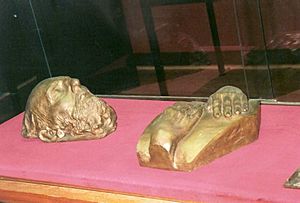
James Ensor is considered a very creative artist from the 1800s. He was different from other artists of his time. But he had a big impact on many expressionist and surrealist painters in the 20th century.
You can find Ensor's artworks in many public art collections. Some important ones are the Modern Art Museum of the Royal Museums of Fine Arts of Belgium in Brussels, the Royal Museum of Fine Arts in Antwerp, and Mu.ZEE in Ostend.
Big works by Ensor are also in the Museum of Modern Art in New York, the Musée d'Orsay in Paris, the J. Paul Getty Museum in Los Angeles, and the Wallraf-Richartz Museum in Cologne. You can see many of his letters in the Contemporary Art Archives in Brussels. All of Ensor's art in Flemish museums can be seen online at the James Ensor Online Museum.
Images for kids
See also
 In Spanish: James Ensor para niños
In Spanish: James Ensor para niños


